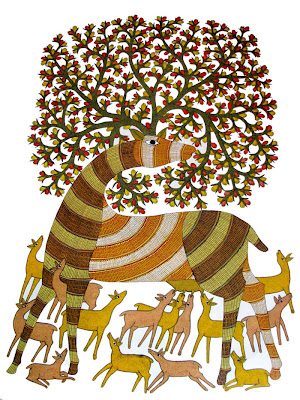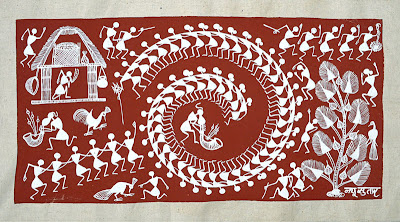There are different types of tribal & folk paintings all over India and each of the styles are different from the others. Some of the basic paintings India as warli, batik, madhubani, miniature and many others. Folk art is an integral part of everyone's life in India, where you get to cross inside the temples. Paintings of India have adopted various techniques and styles on their journey into the world of the arts. Cave paintings are valuable visual documents of history.
Miniature Art - Miniature Paintings are practiced in Jaipur and Bikaner regions of Rajasthan. Miniatures paintings are intricate, colorful handmade illuminations or paintings, small in size, executed meticulously with delicate brushwork. The colors used in the Asian art miniatures are derived from minerals, vegetables, precious stones, indigo, conch shells, pure gold and silver. These Asian art miniatures recreate historical episodes or tales of mythology in Schools that have come to be identified with the different kingdoms that merged in Rajasthan. Fine brush strokes signify miniatures from Jaipur and Udaipur. The colorful illuminations, which captured the fancy of the royalty and aristocracy, emerged in the medieval period. The illustrated manuscripts of Jains and Buddhists, and the flowering of the Mughal, Rajput, and Deccan Miniatures are noted for their meticulous execution and artistic skills.
The fine stroke of brushes conveyed the themes from the Ramayana, Mahabharata, Bhagvata Purana, Rasikpriya, Rasamanjiri, etc.These masterpieces of yore have a universal appeal which still touches the right chord of the audience. The irony of history never ceases to amaze. The mighty Himalayas nurtured in its western valleys, a School of Paintings known as the “Miniature”.
Batik Art - Batik art of India Asian paintings come from Bengal. Batik art refers to the art of dyeing fabric by making use of resist techniques, covering areas of cloth with a dye resistant substance to prevent them from absorbing colors. The technique of Batik art dates back a thousand years and can be traced to India.
Batik art is created in several ways like splash method, screen printing method, and hand painting one is by a Kalamkari pen. As patterns are applied by actual drawing rather than by weaving with thread, the artists can put forth their best in terms of creativity and imagination. The Batik art fabric is in high demand as dress materials, designer home decor and also as forming an important part of contemporary fashion accessory.
Gond Paintings - Tribal art of India Gond paintings of Madhya Pradesh, specially the wall paintings of Bundelkhand, Gondwana, Nimar and Malwa are living expressions of the village people, deeply linked with their day to day lives. They are not mere decorations but also instant expressions of their religious sentiments and devotions.
The tribal folk art gond paintings, based on local Indian festivals like Karwa Chauth, Deepawali, Ahoi Ashtami, Nag Panchmi, Sanjhi etc. are done by women using simple homemade colors. In the Gondwana region, the Gond and the Pardhan tribes who have impressed audiences at exhibitions in Japan, France , Australia and other countries, have showed unmatched creative vision. A community of professional artists does the paintings. Horses, elephants, tigers, birds, gods, men and objects of daily life are painted in bright and multicolored hues.
Kalamkari Painting - Folk art of India Kalamkari painting is pen drawings on cloth. Andhra Pradesh are famed for Kalamkari paintings. This folk art form derives its name from kalam or pen, which is used to trace outlines patterns and images. The Kalamkari technique involves drawing outlines with burnt tamarind twigs dipped in molasses and iron fillings.
The vegetables dyes of deep shades are used to create religious scenes. The final effect comes with repeating the process of coloring. The uniqueness of these painting is that no two panels are similar. Vegetable and mineral pigments are used to create these paintings. The artists believe in using natural dyes, extracted from bark, flower and root. One would be stunned to know that the colour red is obtained by using the Indian madder root, yellow from the pomegranate seed or even mango bark, and black from myrobalam fruit. The process used for both schools of Kalamkari painting is more or less the same. The only major difference is that Srikalahasti paintings depend entirely on the brush-like pen whereas the Masulipatnam style uses block-printing procedures. The process done in Srikalahasti is more tedious. The cloth is treated and washed twice, and two or three times alum is painted.
Madhubani Paintings - Rare Indian Art and Crafts From a Village in India Madhubani Paintings From North India. Madhubani is a small village in Bihar, in India. This undistinguished little village is the heartland of the internationally acclaimed school of folk art painting called 'Madhubani' or 'Mithila' painting. Themes revolve around Hindu Gods and mythology, along with scenes from the royal court and social events like weddings.
Generally no space is left empty; the gaps are filled by paintings of flowers, animals, birds, and even geometric designs. Colors applied have no shading. Normally a double line is drawn for the outlines, with the gap between the lines filled by cross or tiny straight lines. In the linear painting, no colors are applied. Only the outlines are drawn. Often, a coat of whitewash is also applied before actually starting the painting. Traditionally, natural colors obtained from plant extracts are used.
Patachitra Paintings - An annual ritual in the famous Jagannath Temple of Puri, a beach town in the State of Orissa, has given rise to one of India's most treasured folk art form, the 'Patachitra'. The origin of the Patachitra paintings can be traced back to the 8th century AD and it is considered as one of the earliest forms of indigenous paintings.
Originating as a ritual, the Patachitra is regarded today as one of the most cherished collectors' items. Although several centuries old, Patachitra continues to be a living art form practiced even today.
Mandala Paintings - Mandala paintings are spirtual buddhist folk art paintings . Mandala with Amitayus Amitabha as the highest deity. The leaves around him also symbolize the instance of his Enlightenment. Amitayus, literally meaning unlimited life, is what Buddha is called in this form.
He is regarded as the God of longevity. The ambrosia vase that is placed on his left palm is his special emblem. His right hand touches the ground while he sits in lotus posture.
Tribal Art Warli -Warli or Worli art always contains groups of people. The themes chosen by the artists are mainly from nature. Harvest is one of their major themes. One other very popular theme is that of a wedding festival. These paintings are mainly created on mud walls of tribal houses. Women are mainly engaged in the creation of these paintings.
Warli paintings express everyday life using extremely basic object forms and just one color - white - on an austere mud base. The painting style is close to pre-historic cave paintings. Warli paintings serve the social and religious aspirations of the people. These paintings do not depict mythological characters or images of deities, but depict social life. Images of human beings and animals, along with scenes from daily life are created in a loose rhythmic pattern.
























3 comments:
Hello
I would like permission to use the image of one of the Gond paintings in your post for a one-time non-commercial purpose. Would you be able to help with this?
Thank you for your time!
Regards
Pavithra
(from Bangalore, India)
hello, I would like to use one of these pictures for a school project, if that is possible. Thank you:)
My Indian culture is really very rich and beautiful
Post a Comment